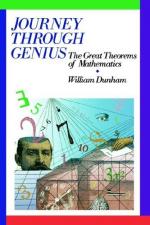
|
| Name: _________________________ | Period: ___________________ |
This quiz consists of 5 multiple choice and 5 short answer questions through Euclid's Proof of the Pythagorean Theorem.
Multiple Choice Questions
1. What did the Pythagorean Theorem accomplish for mathematics?
(a) The concept of providing a logical proof.
(b) The concept of constructing useful mathematics.
(c) The ability to measure angles.
(d) The ability to find square roots.
2. What did Dunham consider extraordinary about the Elements?
(a) How Hippocrates ordered the book.
(b) The content was not based on previous authors' work.
(c) The content was totally unique.
(d) How geometric proofs were presented.
3. "Straight lines in the same plane that will never meet if extended forever" is a definition of what?
(a) Circle.
(b) Parallel lines.
(c) Intersection.
(d) 180 degree angle.
4. Who was the author of the book Elements?
(a) Hippocrates.
(b) Einstein.
(c) Lindemann.
(d) Euclid.
5. Which of the following was NOT one of Gauss' discoveries?
(a) That under Euclid's definition parallel lines can intersect.
(b) "Non-euclidean" geometry.
(c) That angles in a triangles can not add up to more than 180 degrees.
(d) That there is no apparent contraction to the assumption that the sum of angles in a triangle can have fewer than 180 degrees.
Short Answer Questions
1. How many definitions were stated in Elements?
2. That properties of specific shapes were early Egyptians aware of?
3. What is the name for determining the area of an enclosed space by constructing a square of equivalent area?
4. According to Euclid, when is a triangle a right triangle?
5. What was Hippocrates's great advance to mathematics?
|
This section contains 325 words (approx. 2 pages at 300 words per page) |

|




